
The Elements and Benefits of Mindfulness: Deepening Learning on Co-op and Beyond
Michael Sweet // Northeastern University
Dori Mazor // Northeastern University
Sarah Klionsky // Northeastern University
Jonathan Andrew // Northeastern University
Michelle Zaff // Northeastern University
Click Here to Download this Article
Abstract
Cooperative education provides an opportunity to integrate academic and workplace learning and to immerse oneself in a chosen discipline, industry, and organization. Through observation and participation in the workplace, students develop new skills and knowledge, as well as greater awareness of their professional and personal values and goals. While not everything about a co-op experience will be in a student’s control, those who have the most satisfying experiences often set the explicit goal of maximizing their own learning. Success on co-op (and beyond) is often rooted in mindfulness, a specific set of practices we can adopt in order to maximize our learning and respond effectively to change. Throughout, we refer to socio-cognitive mindfulness in the context of self-directed learning (rather than meditation). This article reviews some of the research on socio-cognitive mindfulness, identifies its three component features, and links them directly to real-life co-op situations in which mindfulness theory and practice come together. The examples provide practical advice on mindful learning, which can foster students’ engagement and professional accomplishment.
INTRODUCTION
Cooperative education provides an opportunity to integrate academic and workplace learning and to immerse oneself in a chosen discipline, industry, and organization. Through observation and participation in the workplace, students develop new skills and knowledge, as well as greater awareness of their professional and personal values and goals. While not everything about a co-op experience will be in a student’s control, the authors’ years of experience with co-op make clear that those who have the most satisfying experiences set the explicit goal of maximizing their own learning. Their approach is mindful: they strive to observe and analyze connections, distinctions, patterns, and routines; identify and pursue new opportunities; extract learning from all interactions and tasks (even those that seem mundane); and discover ways to enjoy their work even in the face of difficulty or disappointment. These students tend to thrive on co-op regardless of whether their actual job lives up to expectations. If the co-op is a great fit, they push themselves to take full advantage of the experience. In the face of real adversity, for example, an ineffective supervisor, organizational strife, or an insufficiently challenging workload, they find ways not just to cope, but to grow personally and professionally.
Success on co-op (and beyond) is often rooted in socio-cognitive mindfulness, a specific set of practices we can adopt in order to maximize our learning and respond effectively to change. While the term mindfulness commonly refers to meditation and Eastern philosophies, socio-cognitive mindfulness is very different: it “pursues a learning agenda, can be very goal-oriented, and involves the use of mindfulness in enhancing problem solving and other cognitive exercises” (Pirson, Langer & Zilcha, 2018). Students at Northeastern University are introduced to the theory and practice of socio-cognitive mindfulness in a preparation class before their first co-op experience. Co-op Faculty include readings (including this article), discussions, and activities that that aim to prepare students to approach their co-op experiences mindfully and in a way that emphasizes learning.
This article reviews some of the research on mindfulness, identifies its three component features, and links them directly to real-life co-op situations in which mindfulness theory and practice come together. The examples provide practical advice on mindful learning, which can foster students’ engagement and professional accomplishment. (Note: the co-op stories are true, but student names have been changed for privacy.)
PART ONE: ELEMENTS OF MINDFUL LEARNING
As change in the world keeps accelerating, every day brings its own learning curve. Scholars have identified a way to navigate our day-to-day experiences to not only stay flexible and productive, but also enjoy ourselves more. This perspective is called “socio-cognitive mindfulness” and it consists of a specific set of practices we can learn.
The word “mindfulness” is often used in reference to various forms of meditation. While meditative mindfulness and socio-cognitive mindfulness have similarities, they are different concepts with different goals and different lines of research. This article is about socio-cognitive mindfulness, which we will refer to simply as “mindfulness” in this paper. It is the habit of constantly taking note of new and different features, experiences, and interactions in one’s environment in the present moment (adapted from Langer, 2014). “Mindful learning” capitalizes on the information gained from being mindful and provides connections and insights that would otherwise be missed.
We have all had the experience of behaving mindlessly. We might eat a take-out dinner while watching TV, for example, barely noticing the taste or texture of the food. Moving through an experience on auto-pilot and acting out of routine is the opposite of mindfulness. A mindful headspace, in contrast, enables us to understand more about our environment and respond rather than react: to act out of choice, intentionally and strategically, instead of out of habit. Eating mindfully, then, might involve consulting a new cookbook, preparing an unfamiliar entrée, and then savoring every bite.
At Northeastern University, we use the work of Dr. Ellen Langer as a basis for our thinking about the role of mindfulness in experiential learning. Langer has been researching aspects of mindfulness for decades and in her view, mindfulness incorporates three main elements:
Let us consider each of these in terms of learning.
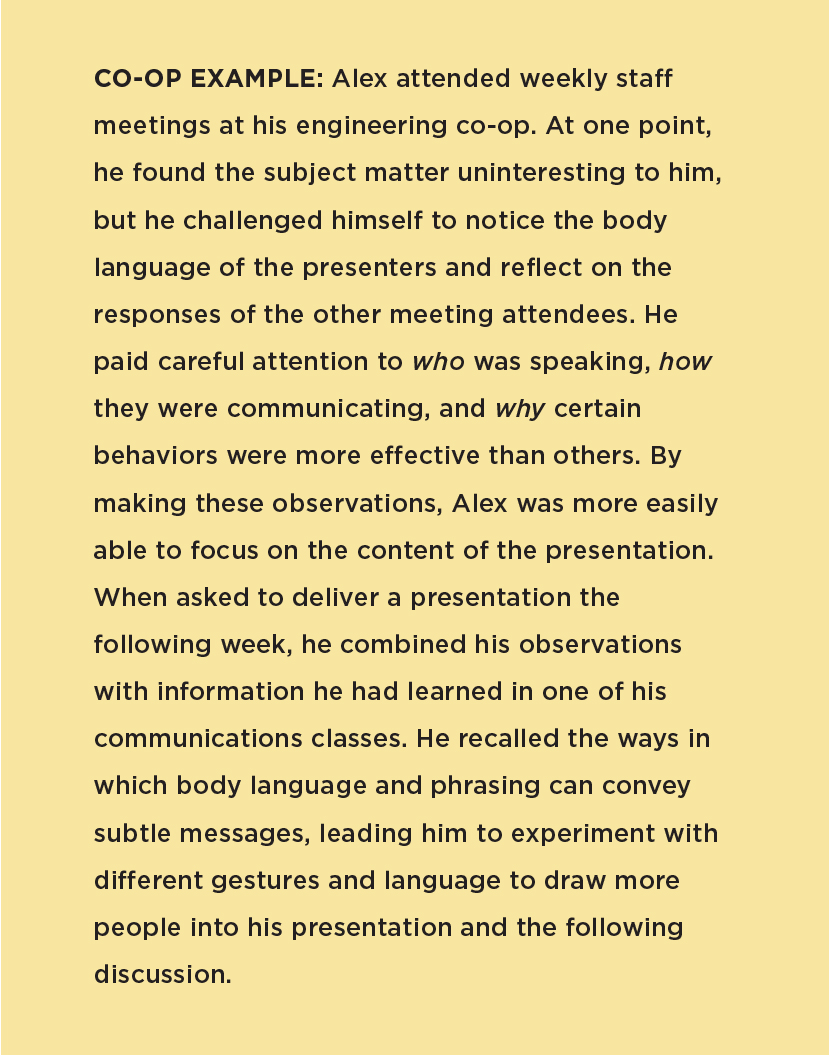
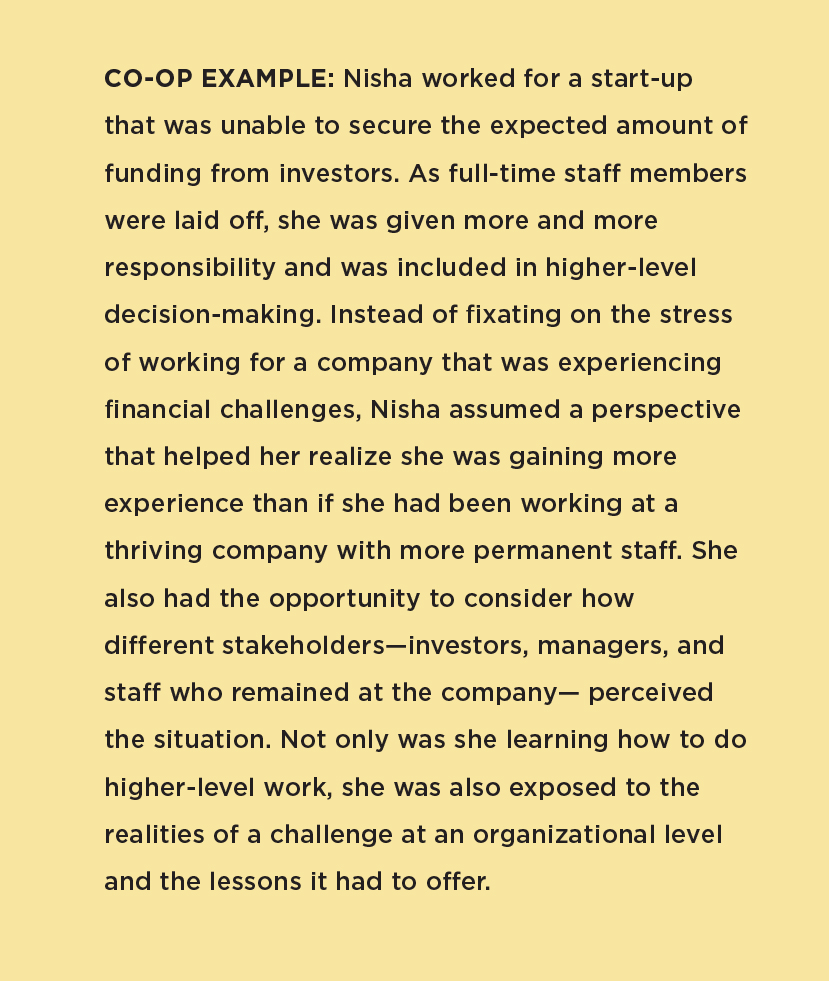
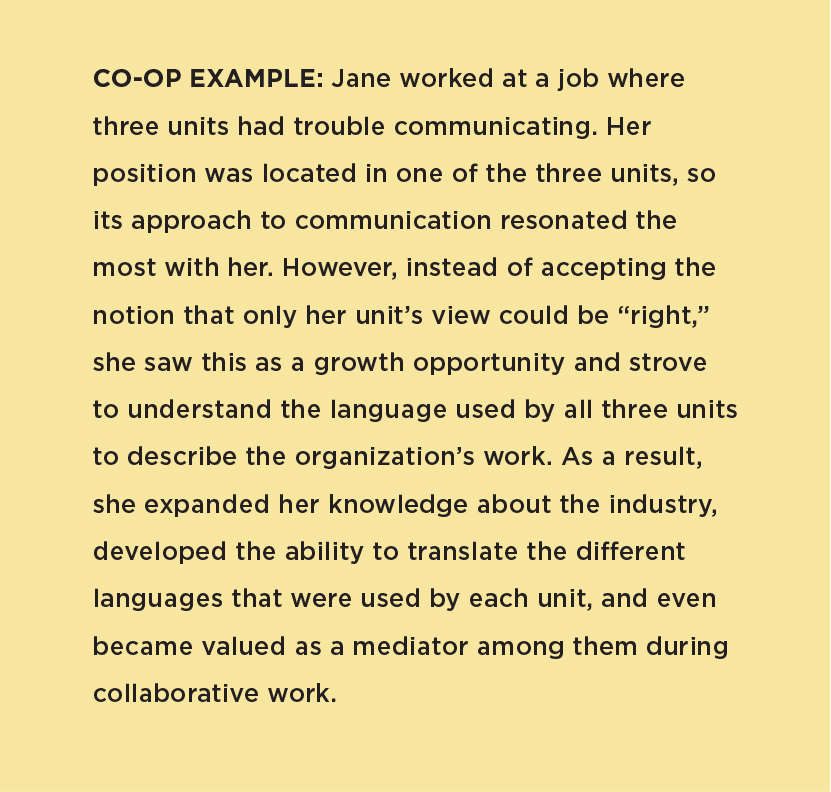
PART TWO: APPLYING PPRINCIPLES OF MINDFULNESS ON CO-OP
Mindfulness keeps us in the present moment, is sensitive to context and perspective, and is guided, but not governed, by rules and routines. But what does mindful behavior and mindful learning look like? What do we actually do when we are being mindful, how can it benefit us, and how can we cultivate these habits?
Langer and her colleagues (2012) have identified three specific mindfulness behaviors: (a) engagement, (b) novelty seeking, (c) novelty producing.
Real-world benefits of engagement –
Engaging with the environment reveals new possibilities as they arise. As circumstances, events, and people continually rearrange themselves in our fast-paced world, it is crucial to track how those changes unfold. We do this not just to operate with maximum effectiveness, but also to recognize new opportunities as they present themselves.
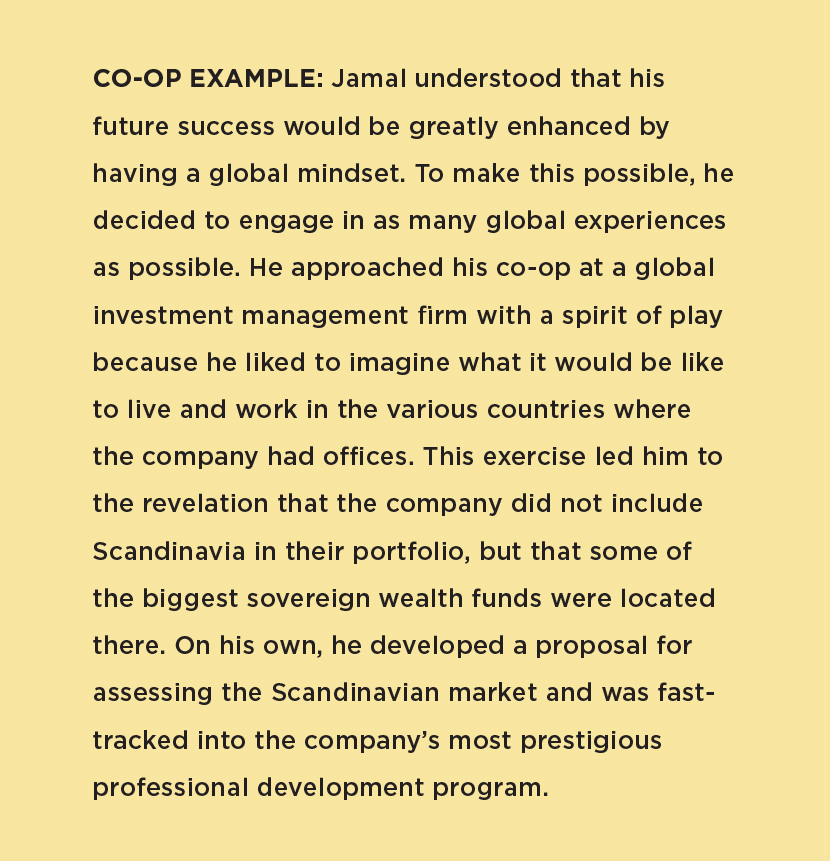
How can we build this habit? – The way we classify tasks can make a big difference in how deeply they engage us and how much we enjoy them. Langer (1997) describes how a sorting exercise was introduced to research participants as either “work” or “a game.” Those who were introduced to the task as work enjoyed the activity much less and reported that their minds wandered twice as often. The same phenomenon applies to many professional situations. For example, if we equate a reduction in workload with boredom, we are likely to squander the extra hours. If we reframe down time as free time, however, we are more likely to take advantage of it, perhaps for networking, or for initiating new projects.
Real-world benefits of novelty seeking habits – Today’s world is one of increasing change and diversity, and a habit of novelty seeking positions us to view our experiences from a flexible perspective. Change and diversity can generate new opportunities for the novelty seeker and provide fuel for creative acts. Further, continually striving to explore new perspectives—rather than letting them threaten or overwhelm us— provides us with a larger and more informed picture of the world in which we operate.
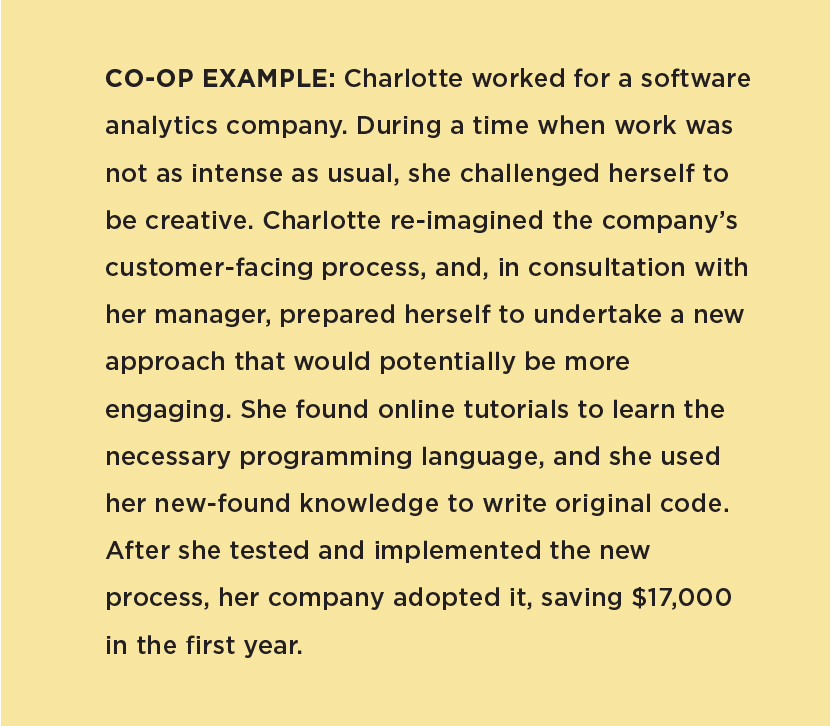
How can we build this habit? – Novelty-seeking is a desire to have new experiences and can be as simple as challenging ourselves on a daily basis to notice a certain number of new things that can be seen, heard, felt, touched, or even smelled or tasted—a practice called “grounding,” which has a documented history of increasing mental well-being (Zerubavel & Messman-Moore, 2013). Further, creativity expert Julia Cameron (2003) recommends dedicating one hour a week to investigating new places or activities for the sole purpose of breaking out of our routines and the habits of our comfort zones. In the context of the workplace, this can mean working beyond the limits of a job description or rethinking established procedures.
Real-world benefits of novelty producing habits – Today’s world demands innovation, and a novelty- producing habit makes innovation a familiar act, even in tiny ways. All forms of innovation can be useful.
Novelty producing can take the more common form of engaging in familiar acts in subtly new ways, or involve more significant departures from the status quo, such as digitizing a paper-based filing system or making toys out of surplus office supplies.
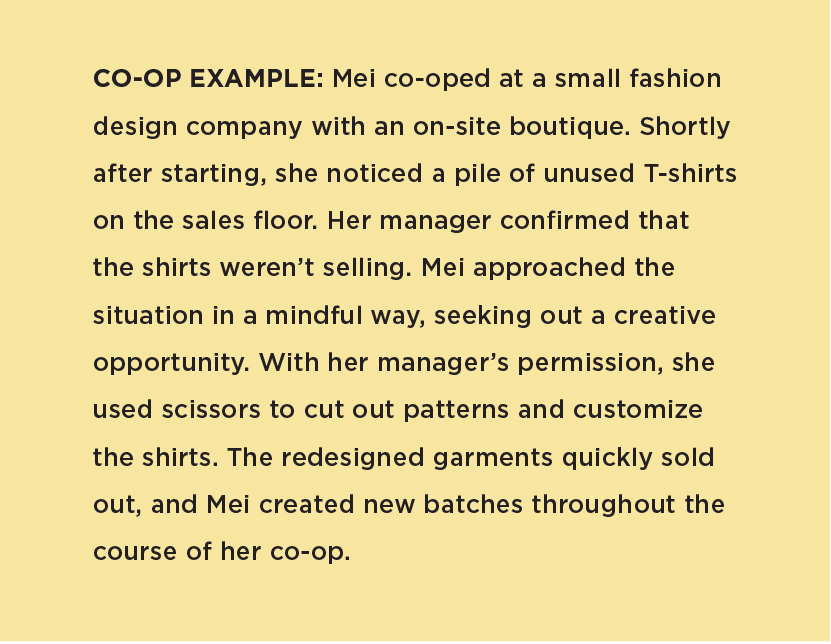
How can we build this habit? – Novelty producing is about creativity, but it doesn’t have to be dramatic to make an impact. One way to build a habit of creativity is to integrate small creative adjustments into daily life. Even subtle creative acts make a noticeable difference and can keep creative juices flowing. For example, in one experiment, Langer, Russell, and Eisenkraft (2009) asked symphony musicians to perform the same piece in two different ways. For the first performance, they asked the musicians to adhere exactly to the score. For the second, they were encouraged to add creative personal nuances, in a manner that was “so subtle that only they would notice.” The result? Both audience members and the musicians themselves preferred the performance that incorporated tiny creative adjustments – the one in which the music was played mindfully. Students can also find small ways to incorporate creativity in a co-op. For example, a graphic design student might be on co-op at a large company with very strict brand guidelines. While the student will have to adhere to specific typefaces and colors, she can challenge herself to incorporate her personal aesthetic into her designs, ultimately increasing her satisfaction and improving her performance.
CONCLUSION
Mindful students—like those featured in the Co-op Examples in this article—seek out new ways to understand their environment and to make contributions. They often return to campus excited about their accomplishments, with stories about how they capitalized on learning opportunities and sometimes overcame challenges in creative ways.
Prompts and activities that are integrated into reflective practices can help students focus on remaining mindful while on co-op and when they return to campus. Students at Northeastern create and refine learning outcomes throughout their co-op experience, and mindful students are able to reflect on the differences in their initial learning goals and their final learning outcomes and use this understanding to frame future aspirations. In conversations, in interviews, and on resumes, they find ways to highlight what went well and learn from what did not. They share their learning with others, and they approach the next step in their careers—whether it is another co-op, a full-time job, or further schooling—with a combination of motivation, curiosity, and creativity.
REFERENCES
Brown, J. S., Collins, A., & Duguid, P. (1989). Situated cognition and the culture of learning.
Educational Researcher, 18(1), 32–42.
Cameron, J. (2003). Walking in this world: The practical art of creativity. New York: NY. Penguin Random House.
Kolb, D. A. (2015). Experiential learning: Experience as the source of learning (2nd ed.).
Langer, E. (2014). Mindfulness forward and back. In A. Ie, C. T. Ngnoumen, & E. J. Langer (Eds.), The Wiley Blackwell handbook of mindfulness. Malden, MA: Wiley and Sons.
Langer, E. J. (1997). The power of mindful learning. Cambridge, MA: Perseus Press. Langer, E., & Piper, A. (1987). The prevention of mindlessness. Journal of Personality and Social Psychology, 53, 280-287.
Langer, E., Russell, T., & Eisenfrakft, N. (2009). Orchestral performance and the footprint of mindfulness. Psychology of Music, 37(2), 125-136.
Miller, G. A., & Gildea, P. M. (1987). How children learn words. Scientific American, 257, (3), 94-99.
Pirson M., Langer E. J., Bodner T., Zilcha-Mano S. (2012). The Development and Validation of the Langer Mindfulness Scale – Enabling a Socio-Cognitive Perspective of Mindfulness in Organizational Contexts (Fordham University Schools of Business Research
Paper). Available at: http://ssrn.com/abstract=2158921
Pirson M. A., Langer E., Zilcha S. (2018). Enabling a Socio-cognitive Perspective of Mindfulness: The Development and Validation of the Langer Mindfulness Scale. Journal of Adult Development, 25(3), 168-185.
Zerubavel, N., & Messman-Moore, T. L. (2013). Staying present: Incorporating mindfulness into therapy for dissociation. Mindfulness, 6, 303-314.